
UNH researchers have identified new, readily available materials that convert sunlight and carbon dioxide (CO2) into building blocks for liquid fuels that could one day heat homes and power cars.
“Currently we can convert sunlight into electricity using solar panels on homes and other buildings,” said Gonghu Li, associate professor in chemistry and materials science. “However, electricity isn’t easy to store on a large scale, and energy production stops when the sun goes down. We wanted to look for something that had more staying power.”
In their study, recently published in the Journal of the American Chemical Society, the researchers outline a promising approach for recycling CO2 by replicating photosynthesis, a process found in green plants that uses sunlight to convert energy. Taking a cue from the plants, the researchers focused their research on developing new materials to harvest natural sunlight and break down chemical bonds in CO2.
"Solar energy production stops when the sun goes down. We wanted to look for something that had more staying power.”
The process is often referred to as "artificial photosynthesis" because it mimics the fuel-forming reaction carried out in plants. The challenge was to make materials based on elements that are abundant on Earth and not scarce or expensive like platinum.
One key ingredient required to break the bonds of CO2 is a supply of electrons. These electrons can be generated when a material known as a semiconductor gets activated by energy in the form of sunlight. The researchers decided on a metal-free semiconductor made from commercially available urea to harvest the sunlight and power the right chemical reactions which can transform CO2, a greenhouse gas, into simpler parts including carbon monoxide that is a building block for creating useful chemicals and fuels.
Additional UNH contributors to the study were postdoctoral researcher Peipei Huang, doctorate candidate Sebastian Pantovich ’14, Thomas Fenton ‘18G and Christine Caputo, assistant professor of chemistry and materials science.
The researchers teamed up with scientists at Brookhaven National Laboratory to access the National Synchrotron Light Source II, a U.S. Department of Energy (DOE) Office of Science user facility, to reveal how the new materials perform so well in this process. This research is based upon work supported by the DOE and the National Science Foundation.
-
Written By:
Robbin Ray ’82 | UNH Marketing | robbin.ray@unh.edu | 603-862-4864

















































